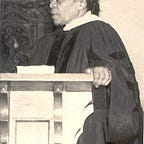History 101: American Missionary Association
In this series, History 101, we’ll explore some of the topics and questions we frequently discuss at the Charlotte Hawkins Brown Museum.
After a year of junior college, a young Charlotte Hawkins accepted a 25-dollar-a-month job from the American Missionary Association (AMA) and returned to her home state of North Carolina to teach poor, rural blacks. She arrived at Bethany Institute in rural Guilford County in 1901.
The American Missionary Association was established in 1846 in New York through an antislavery coalition of the United Missionary Association, the Committee for West Indian Missions, and the Western Evangelical Missionary Society. The AMA’s founders believed that slaveholding was a personal sin no matter what the reasons or motives underlying it. It is important to note, the leaders that founded the AMA were of both races and believed in equality of races and insisted on integration in all their activities. In addition to sending missionaries overseas and working with immigrants and poor whites in the United States, the AMA founded more than five hundred schools and colleges for the freedmen of the South during and after the Civil War.
At the onset of the Civil War, the American Missionary Association had already been around for a couple of decades. AMA missionaries and teachers followed the Union armies, establishing schools as soon as military occupation allowed. The AMA’s pace of founding schools and colleges increased during and after the war, making education a priority for the newly freed people. Some of the schools that the AMA played a major role in establishing in the South: Howard University, Hampton Institute, Atlanta University, Fisk University, and Talladega College.
The AMA started opening schools in North Carolina in 1863. The first schools were established in black churches across the state. The early focus was to teach elementary ages, at this time illiteracy was high among blacks in the South. Eventually the AMA would realize its goals of giving access to industrial and technical training, teacher and professional training, and giving liberal arts and collegiate level education to all.
By 1902, an overextended AMA announced that it would close Bethany Institute and other small schools in order to focus its support on more established normal schools. The AMA was beginning to shift its resources towards more two-year normal and industrial institutes and its colleges. According to historian Charles Wadelington, once the AMA pulled funding from Bethany Institute, Dr. Brown was “had the option of either accepting a new assignment with the AMA or continuing her school alone.” Inspired by the pleas of the community, Brown bravely chose to remain in Sedalia and continue educating students without the support of the American Missionary Association.
This was not the last time that Brown worked with the American Missionary Association, however. From 1926 to 1934, Dr. Brown and the AMA worked together to support Palmer Memorial Institute through its tremendous growth. With AMA support in place, Palmer added three brick buildings (girls dormitory Galen Stone Hall, boys dormitory Charles W. Eliot Hall, and Kimball Hall), Canary Cottage, and added modern utilities which greatly increased the value of the physical plant. The support of the American Missionary Association secured Palmer Memorial Institute’s ability to remain open during the Great Depression. In 1934, when the AMA pulled support from Brown for the second time, she was ready and able to continue to fundraise on her own to see that the school would continue to be successful and remain open.
